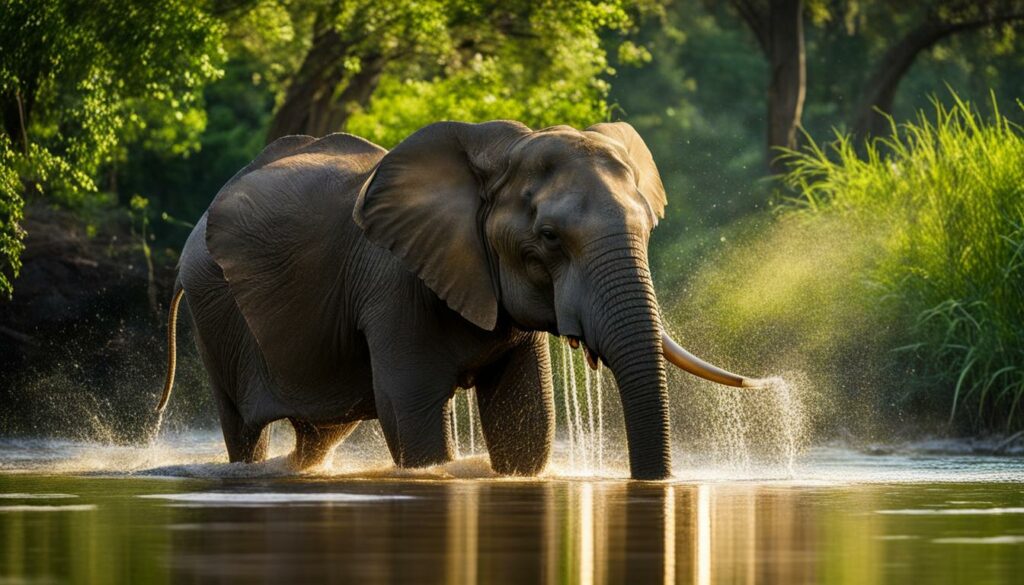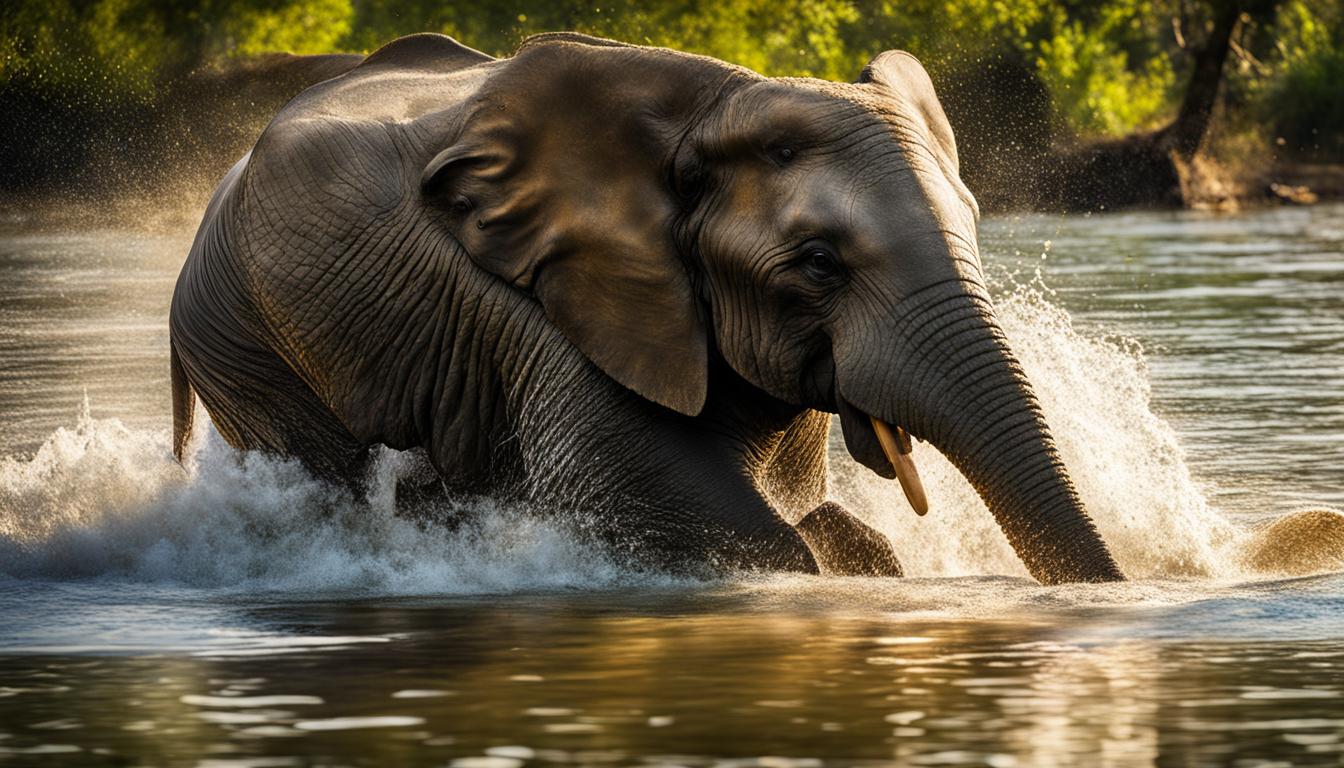Elephants have a fascinating relationship with water, showcasing their natural swimming abilities and affinity for this element. They interact with water in various ways, including swimming, playing, and bathing. Recent studies even suggest that elephants may have an aquatic ancestry, which explains their unique adaptations for swimming.
Water is a vital resource for elephants, and their interactions with it serve multiple purposes. They use water for drinking, evaporative cooling, bonding, and even socializing. Their large bodies help them float, and their trunks and lungs are uniquely adapted for swimming and breathing in water.
In this article, we will explore the importance of water for elephants, their behaviors and interactions in water, and the fascinating evolutionary history that gives them their exceptional swimming abilities. Join us as we dive into the captivating world of elephants and their relationship with water.
Importance of Water for Elephants
Water is of utmost importance for elephants, playing a vital role in their survival, habitat, and the overall ecosystem. Elephants require a substantial amount of water for their daily needs, consuming up to 200 liters per day. This need for water has shaped their migration routes, as they are known to travel long distances in search of reliable water sources. It is fascinating to observe how elephants have adapted to their environment, relying on water not just for drinking but also for cooling, bathing, and cleaning.
Elephants possess a unique physiology that makes water crucial for their well-being. Unlike humans, elephants do not sweat, and therefore, they rely on water to regulate their body temperature. Bathing in water helps them cool down, and they spend approximately an hour each day engaging in this activity. They even use their trunks to squirt water over themselves, ensuring that the water gets trapped in the wrinkles of their skin, increasing the surface area for evaporation and further enhancing the cooling effect.
Furthermore, water plays a significant role in shaping the behavior and social dynamics of elephants. Natural water sources such as rivers and dams provide opportunities for elephants to interact, bond, and socialize. Waterholes, in particular, become gathering places where elephants come together as a herd, fostering social connections and allowing the younger elephants to learn from their elders. These watering sites also showcase the protective nature of elephants, as they rally around vulnerable members to ensure their safety in the water.
In summary, water is essential for the survival and well-being of elephants. Conservation efforts to protect their habitats and ensure access to water sources are crucial for the long-term sustainability of both elephants and the ecosystems they inhabit. Understanding the importance of water for elephants provides valuable insights into their behavior, adaptation, and overall evolutionary history.
How Elephants Interact with Water
Elephants have a remarkable affinity for water and engage with it in a variety of ways. Whether it’s bathing, swimming, or simply playing, water holds great significance in their lives. Let’s explore how these magnificent creatures interact with water in their natural habitats.
Bathing for Hydration, Cooling, and Cleanliness
One of the most common ways elephants interact with water is through bathing. They spend about an hour each day splashing and submerging themselves in water to cool off and maintain hydration. During this time, they use their trunks to squirt water over their bodies, creating a refreshing mist. The water gets trapped in the wrinkles of their skin, providing a larger surface area for evaporation and assisting in the cooling process. Additionally, bathing helps elephants keep their skin clean from dust, dirt, and parasites.
Swimming and Playing in Natural Water Sources
Elephants are not only adept swimmers but also thoroughly enjoy spending time in natural water sources such as rivers and lakes. They can swim by moving all four legs while using their long trunks as snorkels, allowing them to breathe while their bodies remain submerged. Their large bodies act as natural floats, enabling them to effortlessly glide through the water. It is a joyous sight to see elephants swimming, playfully splashing, diving, and even rolling around in the water. This playful behavior not only allows them to cool off but also provides an opportunity for socializing and bonding within their herd.
| Elephant Interaction with Water | Description |
|---|---|
| Bathing | Elephants spend about an hour each day bathing to cool off, maintain hydration, and keep their skin clean. |
| Swimming | Elephants are natural swimmers and can swim for hours using all four legs and their trunks as snorkels. |
| Playing | Elephants playfully splash, dive, and roll around in the water, providing opportunities for socializing and bonding within the herd. |

Elephant Behavior in Water
As elephants interact with water, their behavior reveals fascinating insights into their social nature and protective instincts. One notable aspect of elephant behavior in water is their propensity for socializing. When in the water, adult elephants often gather together, spending time in each other’s company. Meanwhile, younger elephants take advantage of the water’s buoyancy to play and interact with their mothers, developing essential social bonds.
Waterholes also provide a stage for elephants’ protective nature. These gatherings become a focal point for elephants to rally around vulnerable members, such as the renowned albino calf, ensuring their safety in the water. This display of herd mentality demonstrates the strong bond and protective instincts that exist within elephant communities, highlighting their commitment to the well-being of their herd members.
Table: The Protective Nature of Elephants at Waterholes
| Behavior | Explanation |
|---|---|
| Formation of a protective circle | Elephants encircle vulnerable members to shield them from potential threats. |
| Alertness and vigilance | Elephants remain watchful and attentive to any dangers that may arise. |
| Herding close to the water | Elephants congregate near the water, ensuring quick access to safety in case of danger. |
| Guiding young and vulnerable members | Adult elephants guide and protect younger or weaker members, ensuring their safety during water activities. |
By understanding how elephants behave in water, we gain a deeper appreciation for their intricate social dynamics and their commitment to their fellow herd members. The water not only serves as a source of enjoyment and bonding for elephants, but also as a platform for them to exhibit their protective instincts.
The Aquatic Ancestry of Elephants
Elephants’ remarkable swimming abilities and their unique trunk adaptations have long been a subject of fascination. Recent studies suggest that these incredible traits can be attributed to their aquatic ancestry. It is believed that elephants may have descended from semi-aquatic ancestors and were closely related to Sirenians, such as manatees and dugongs.
The evolutionary connection between elephants and their aquatic ancestors is supported by chemical analyses of fossils, which indicate that ancient elephants spent significant time in water and consumed freshwater plants. Over time, elephants adapted to a terrestrial life but retained their ability to navigate through water with ease.
“Elephants’ natural swimming abilities and their trunk’s snorkeling function are remnants of their aquatic past.”
Elephants’ trunks, with their incredible flexibility and strength, serve as a multifunctional tool both on land and in water. When swimming, elephants use their trunks as snorkels, allowing them to breathe while keeping most of their bodies submerged. This adaptation enables them to remain hidden from predators while crossing rivers or accessing submerged vegetation.
The aquatic ancestry of elephants not only explains their swimming abilities but also sheds light on their profound affinity for water. From enjoying a playful swim to using water sources for cooling and bathing, elephants’ interactions with water are deeply rooted in their evolutionary history.
The Evolutionary Connection
The evolutionary connection between elephants and their aquatic ancestors provides a fascinating glimpse into the complex history of these majestic creatures. Understanding their unique adaptations and behaviors in water enhances our appreciation for the diverse range of life forms and their relationship with the environment.
Conclusion
Elephants have a strong affinity for water and interact with it in various ways. From swimming and playing to bathing and socializing, water plays a significant role in their lives. Their natural swimming abilities and unique adaptations, such as the use of their trunks as snorkels, make them exceptional swimmers.
Water is essential for elephants’ survival, and conservation efforts are crucial to protect their habitat and ensure access to this vital resource. Understanding how elephants interact with water provides valuable insights into their behavior and evolutionary history. Water is truly a captivating element in the world of elephants.
Do Elephants Use Swimming as a Form of Communication in the Wild?
Elephant communication in the wild involves various methods, but swimming is not typically considered one of them. Elephants mostly use vocalizations, body language, and infrasound to convey messages among their herd. Swimming is primarily an adaptation for survival, allowing elephants to cross rivers and access resources.
FAQ
Do elephants naturally swim?
Yes, elephants are natural swimmers and enjoy interacting with water in various ways.
How do elephants use water?
Elephants use water for drinking, cooling, playing, bonding, and swimming across rivers.
Can elephants stay underwater while swimming?
Yes, elephants can remain submerged below the water’s surface while using their trunks as snorkels.
How much water do elephants need?
Elephants need to drink up to 200 liters of water per day.
How do elephants cool down in water?
Elephants bathe in water for about an hour each day to keep cool and maintain hydration.
Can elephants float in water?
Yes, elephants’ large bodies help them float, and their trunks and lungs are uniquely adapted for swimming and breathing in water.
Are elephants social in water?
Yes, elephants use water as a means of socializing, where adults meet and spend time together while younger elephants play and interact with their mothers.
Do elephants have an aquatic ancestry?
Recent studies suggest that elephants may have descended from semi-aquatic ancestors and were closely related to Sirenians such as manatees and dugongs.
Why is water important for elephants?
Water is essential for elephants’ survival, and they need it for drinking, cooling, bathing, and cleaning.
How can we help conserve water for elephants?
Conservation efforts are crucial to ensure the survival of elephants and the sustainability of their habitat.











